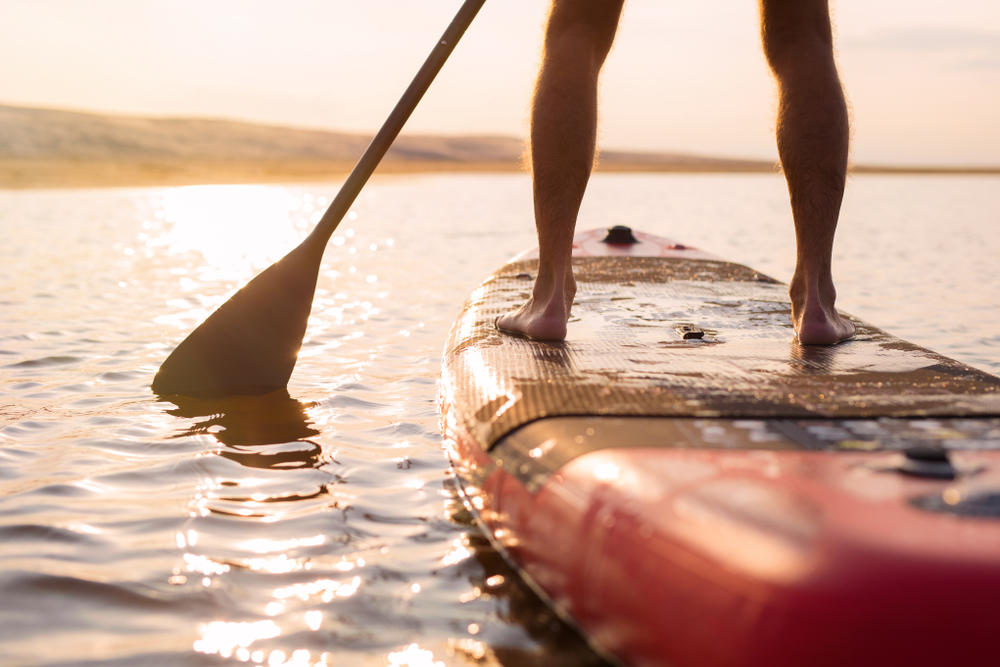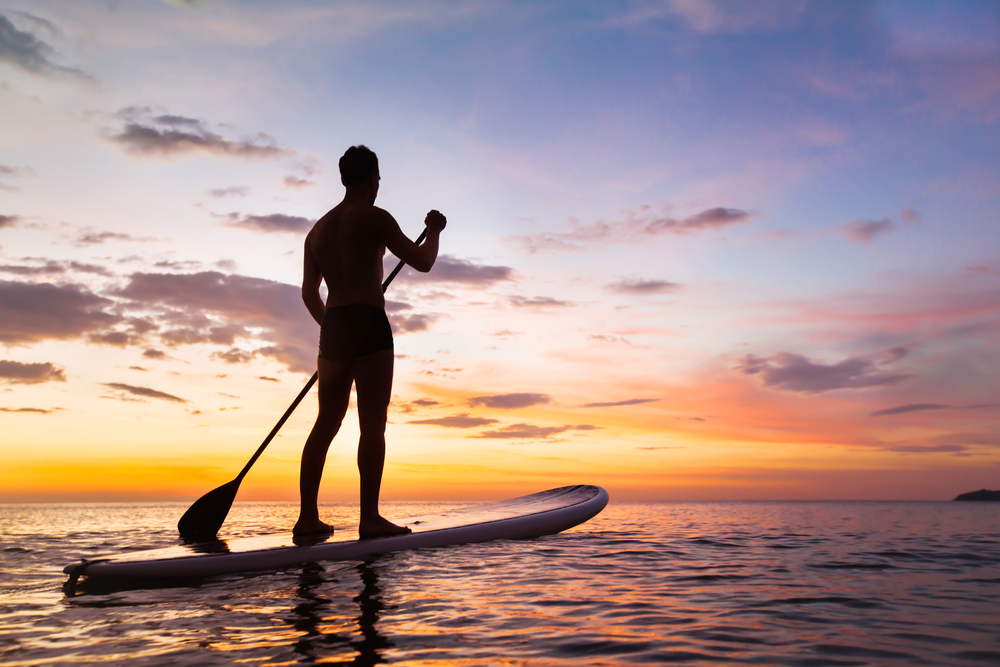Paddleboarding, or Stand-up Paddleboarding (SUP), is a popular activity seen at beaches, state parks, rivers, and lakes. One paddle is used to propel and steer users through the body of water as they kneel or stand on a long board. Paddleboarding is an excellent workout that anyone can participate in without feeling intimidated and is incredibly fun!
Paddleboarding is considered a great workout as it is low intensity, but powerful in burning calories and building muscles. This activity is proven to build strength in your upper body, core, and legs, specifically the quadriceps. On top of the physical benefits, paddleboarding allows you to see nature, make new friends, as well as enjoy meditation.
In this article, we’ll explore what makes the activity of paddleboarding such a good workout to participate in! Let’s paddle into the details.
Contents
- Is Paddleboarding Good for Weight Loss?
- How Many Calories Can I Burn Paddleboarding?
- How Often Should You Paddleboard?
- Is Paddleboarding Good for Cardio?
- Is Paddleboarding Good for Strength Training?
- What Are the Benefits of Paddleboarding?
- Disadvantages of Paddleboarding
- Is Paddle Boarding or Kayaking a Better Workout?
- How to Improve Paddle Boarding
Is Paddleboarding Good for Weight Loss?
Paddleboarding is great for weight loss as it burns major calories, builds full-body strength and is low intensity. Be sure to pair this activity with a balanced diet and active lifestyle.
It is important to note that the decision of what makes an activity a “good” workout depends on your personal fitness goals.
Does Paddleboarding Burn Belly Fat?
Yes, paddleboarding is a great way to burn belly fat! While paddleboarding, your core is engaged to keep yourself balanced on the board.
Keep in mind that paddle boarding is not a magic detox that will have you shedding pounds on its own. Those consistent with this workout, as well as keeping up with a healthy diet are most likely to see the quickest results.
Is Paddleboarding Good for Your Back?
The activity of paddleboarding is a great way to strengthen your back and core. Use your core to balance and the muscles in your arms and back to paddle your way through the waters. While paddling, it is important to keep this proper form. Paddling with a hunched-over back could lead to soreness, injury, and other negative consequences.
If you have chronic or serious back problems, it is a good idea to consult your doctor. This rule of thumb should stand before participating in any physical activities, including paddleboarding
How Many Calories Can I Burn Paddleboarding?
That depends on a few different factors. First, take the level of intensity with which you work out. This can depend on your pace, the calmness of the water, and whether you choose to sit or stand.
Combining that with the amount of time and factors pertaining to your body type and function will equal the number of calories burned.
On average, someone paddling at a casual pace will burn 430 calories per hour and increase from there. A moderate paddler can expect to burn about 540 calories, while an advanced paddler burns up to 708 calories.
| Activity | MET | Calories Burned |
|---|---|---|
| Paddleboarding | 6 | 430 |
| Walking | 2 | 210 |
| Swimming | 6 | 426 |
As you can see from the chart, paddleboarding can burn up to two times the number of calories burned when going for a walk. Learning this might make you want to hit the water as quickly as possible!
To get an accurate number of your own calories burned you can use the following equation: total calories burned in 1 minute = (3.5 times the metabolic equivalent or MET multiplied by your body weight in kilograms)/200.
How Often Should You Paddleboard?
Paddleboarding is a low-intensity activity that can be done every day if you choose. As a rule of thumb, 3 times per week is a great amount to start with for any workout.
It is important to be aware of the waters you are paddling in. For example, if you are paddling in the ocean, you should always check how rough the waters are for that particular day. High winds can create choppy waters that are unsafe to swim and paddle in.
If the waters are too rough, you should skip the activity for the day or choose a calmer water elsewhere.
Is Paddleboarding Good for Cardio?
Paddleboarding is an effective cardio workout that increases stamina. The fact that it is low intensity may have you surprised, which is understandable. When we think of cardio, it is common to think of activities that get our heart rate pumping and our chest working in overdrive to provide us oxygen.
Keeping this in mind, paddleboarding will not be as good of a cardio exercise as activities such as running, rowing, or using the elliptical. However, paddleboarding can provide you the tools to go farther in your cardiovascular workouts.
Is Paddleboarding Good for Strength Training?
Strength training is perhaps the most beneficial element of paddleboarding. It provides full-body resistance training which targets multiple areas of the body. Increased paddling over time improves muscular endurance and increases muscular strength.
Paddleboarding works a number of muscle groups, let’s break down how each muscle is used during this activity.
- Upper Body: as you paddle through the water using an ore, your upper body is used to guide you forward. Specifically, the biceps, triceps, and deltoids are getting worked. Additionally, you can count on your grip to be strengthened as you hold onto the paddle.
- Core: anytime balance is involved in an activity, your core will be actively at work! Paddleboarding is no exception. Rougher waters will require more work from your core to keep you upright. This muscle group is actually used the most, which you may not notice while paddling.
- Legs: your legs, specifically the quadriceps, are another area that is heavily used when balance comes into play. As you stabilize your body, your quads become engaged. When paddling, it is always best to keep your legs slightly bent to increase balance.
What Are the Benefits of Paddleboarding?
Besides the clear physical benefits that paddleboarding provides, there are a number of other reasons you should be participating in this enjoyable activity.
1. See Nature in a New Way
Whether you paddle through the ocean, lake, or river – you will see some amazing sights. Paddleboarding allows you to see nature in a way you may never have. Imagine the sun shining on your face, and the smell and calmness of waters surrounding you. All while creatures such as fish, birds, and woodland animals interact in their natural habitat.
2. Perfect Meditation Setting
As you can imagine, being submerged in nature is a perfect place to gather your thoughts. Taking a moment to set intentions for the day or reflect on life has many benefits to our mind. Participating in these types of thoughts is shown to reduce stress.
3. Make New Friends
Paddleboarding can be a great activity to enjoy alone or with friends. Getting involved in a paddleboarding group can be beneficial for your social interactions. This allows you to meet new people, paddle on routes you didn’t know about, and have company while paddling.
Disadvantages of Paddleboarding
The benefits of paddleboarding are great, mentally and physically. With this in mind it is important to note that this activity may not be right for everyone. Below are a few disadvantages to paddleboarding:
1. Must Rely on Weather
The biggest disadvantage to paddleboarding is relying on the elements to be able to participate. If it is rainy, windy or temperatures are low, you may have to skip your paddleboarding session for the day.
2. Getting Wet
If getting wet was not part of your plan for working out, this activity probably is not for you. Although you’ll stay mostly dry while standing up on the board, there is always the possibility of falling and getting completely drenched. Most paddlers will wear a bathing suit.
3. Could Get Lost
If you are not familiar with the area you are paddling in, you could get lost. This could be stressful while paddleboarding because you are surrounded by water, which limits your ability to understand direction. To prevent this, it’s best to follow a planned route or stay where you can always see the shore.
Is Paddle Boarding or Kayaking a Better Workout?
While Kayaking is fun and still a great workout, the primary muscles used are your arms and core. Paddleboarding, as we know, utilizes your entire body. If you are looking for a more effective workout, Paddleboarding will be your go-to.
Kayaking can burn up to 500 calories per hour, for the most rigorous workout. This number depends on the intensity of activity and the waters. Paddleboarding burns an average of 430 calories for a leisurely paddle. A moderate paddler can expect to burn about 540 calories, while an advanced paddler burns up to 708 calories.
How to Improve Paddle Boarding
1. Face the Right Way
For beginners, it might not be obvious which end of the paddleboard is the front and back. When you get on the board, be sure that the fin on the bottom is in the back. This will help with balance and grip while you ride the waves! Fin in the front leads to a choppy, unbalanced ride.
2. Look at the Horizon
Looking at your feet to see if you are balanced might be your first inclination. But the best way to stay upright is by keeping your body straight and head facing forward. Pick a spot on the horizon and enjoy the views.
3. Ride Waves You Can Handle
Mother nature can be more powerful than you think. Before you paddle and even during your session, make sure you are riding waves you can handle. It takes one big wave to knock you off of your board which could lead to injuries. Additionally, always make sure to check the waters before going out, as we mentioned earlier.
4. Always Use a Leash
Using a leash is an important safety measure for you and others paddling around you. Your paddleboard is also flotation device. Should an incident happen, your paddleboard can be used in an emergency to keep you floating rather than under the water.
Keeping the board tethered to you means that it will not float away if you fall off. It is also safer for others not to have a rogue paddle board drifting and bouncing around them, as they could become injured as well.



